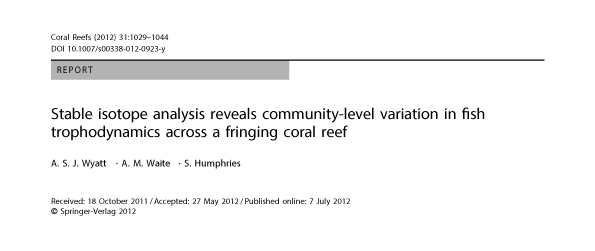Stable isotope analysis reveals community-level variation in fish trophodynamics across a fringing coral reef
A. S. J. Wyatt, A. M. Waite, S. Humphries
In contrast to trophodynamic variations, the marked zonation in physical and biological processes across coral reefs and the concomitant changes in habitat and community structure are well documented. In this study, we demonstrate consistent spatial changes in the community-level trophodynamics of 46 species of fish across the fringing Ningaloo Reef, Western Australia, using tissue stable isotope and fatty acid analyses. Increasing nitrogen (δ15N) and decreasing carbon (δ13C) isotope ratios in the tissues of herbivores, planktivores and carnivores with increasing proximity to the ocean were indicative of increased reliance on oceanic productivity. In contrast, detritivores and corallivores displayed no spatial change in δ15N or δ13C, indicative of the dependence on reef-derived material across the reef. Higher δ13C, as well as increased benthic- and bacterial-specific fatty acids, suggested reliance on reef-derived production increased in back-reef habitats. Genus-level analyses supported community- and trophic group-level trends, with isotope modelling of species from five genera (Abudefduf sexfasciatus, Chromis viridis, Dascyllus spp.,Pomacentrus spp. and Stegastes spp.), demonstrating declining access to oceanic zooplankton and, in the case of Pomacentrus spp. and Stegastes spp., a switch to herbivory in the back-reef. The spatial changes in fish trophodynamics suggest that the relative roles of oceanic and reef-derived nutrients warrant more detailed consideration in reef-level community ecology.

